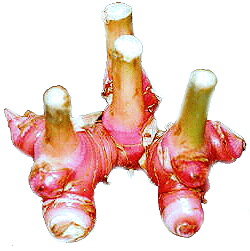 Galangal
(Alpinia officinarum) Galanga,
Galengale, Galingale, Garingal,
Colic root, East India root
Galangal
(Alpinia officinarum) Galanga,
Galengale, Galingale, Garingal,
Colic root, East India root
Greater
:
Languas galangal, syn Alpinia galanga
Lesser: Languas officinarum, syn Alpina
officinarum
Kaempferia: Kaempferia galanga, Kaempferia
pandurata
A close relative of
ginger, galangal is an important and popular ingredient in the
foods of Indonesia and Southeast Asia, especially in Thailand
and is usually found in market in sections of from 1 inch to 4
inches in length, and of a reddish-brown color, as though
covered with rust. Ground
Galangal (formerly called Laos powder) is easier to work with
than whole Galangal and is commonly called for in recipes. The
flavor is similar to ginger, but more flowery and intense. Use
small amounts when starting out. Its flavor combines with ginger
and lemon grass in Thai cooking, and with white pepper and/or
cayenne for seasoning fish, meat or poultry. From Thailand.
The name
galangal is said to be derived from the Arabic Khanlanjan,
which, in turn, is perhaps the perversion of a Chinese word,
signifying mild ginger. Galangal has long been an article of
commerce with the Eastern nations, and has been known in
Northern Europe since the twelfth century.
The plant
from 2 to 4 feet high, erect, and bears a close resemblance to
the common cultivated canna, or shot plant and smooth parallel-veined
leaf blades are about a foot long, 2 to 4 inches wide, ,
In many countries the
galangal has not come into use among physicians, but is sold
extensively in ethnic markets and by street-corner venders under
such names as "colic root," "the wonderful East India root,"
etc., and is said to be a certain cure for toothache, headache,
upset stomach, etc.






































